
Lessons Learned at the Local and State Levels from the Nation’s First Offshore Wind Farm
by Marisa McNatt
In addition to potentially reducing U.S. carbon emissions, the available energy from U.S. offshore wind resources is twice as large as the electricity demand for the United States, even after accounting for currently available offshore wind technology and land-use and environmental exclusions, (Musial et al., 2016). But, actually tapping into the rich, carbon-free energy resource in the U.S. has proven immensely difficult. Since the early 2000s, a complex array of political, social, economic and other factors have blocked more than 70 offshore wind farms proposed for U.S. coastal waters.
I’m studying these barriers to developing U.S. offshore wind farms, as a Ph.D. candidate in Environmental Studies at CU Boulder, with the Center for Science and Technology Policy Research. The U.S. realized its first offshore wind farm in September 2016, located in the Atlantic Ocean, about three miles southeast of Block Island, Rhode Island. The completion of the 30-megawatt capacity, 5-turbine Block Island Wind Farm by developer Deepwater Wind, was a historic moment for the nation, and provides the opportunity to research what made this project successful.
That it has taken so long for the U.S. to harness energy from an offshore wind farm appears somewhat surprising, when you look at the European Union (EU). Many Europeans, particularly those living near the coast of the UK, Denmark, and Germany have been producing electricity with energy from wind at sea since the world’s first offshore wind farm was constructed off the coast of Denmark in 1991. In 2015, 11 European countries had a total of 3,230 turbines, comprising more than 70 offshore wind farms, installed and connected to the grid (European Wind Energy Association, 2016). The European example demonstrates, of course, that it’s possible to construct massive power facilities in the ocean.
On the other hand, just because it can be done, doesn’t mean it’s easy — there’s nothing small, inexpensive or simple about an offshore wind farm. A single offshore turbine, including the blades, tower, rotor and foundation can cost about $12 million, have a collective mass well over 1,000 tons, and can stand twice as tall as the Statue of Liberty. Besides the turbines and foundation, an offshore wind farm requires miles of undersea cable and substations to connect electricity generated from the wind farm to the grid, specialized vessels with gigantic cranes to assemble the turbines, a multitude of support vessels and a knowledgeable crew that must account for extreme sea and weather conditions. Before a developer can even think about construction, there’s an enormous number of studies that must be done to mitigate the impact of an offshore wind farm on human and environmental communities, including research on animals that live in the seafloor, migratory mammals and birds, vessel traffic, fishing areas, and more. In the U.S., a developer must obtain a multitude of municipal, state, and federal permits that comply with the Clean Water Act, the National Environmental Policy Act, and the Endangered Species Act, to name a few. While addressing these many development components, a developer must also attract investors to finance a project and think about a range of stakeholder issues.
Without a doubt, offshore wind development clearly requires long-term policy support and clear strategy to be successful — that’s primarily why the industry has taken off in Europe, and not in the U.S. The UK and Germany, for example, have mostly maintained political support for offshore wind development for about two decades, despite changes in political regime. In recent years, in spite of the fossil fuel industry receiving billions in subsidies under the Obama Administration, the U.S. federal government has built up strong political will and goals for offshore wind, such as conducting baseline studies, auctioning off parcels of the ocean for commercial wind leases, and creating offshore wind task forces that include stakeholder representatives from various states.
Although there are many reasons to advance responsible offshore wind development — the industry could bring numerous jobs and economic development to the U.S. and lower electricity prices in some regions for the long term — having strong climate change policies doesn’t hurt. As an example, a recently published report from the U.S. Department of Energy and the U.S. Department of the Interior, on a national strategy for offshore wind, states that the U.S. federal and state policy environment has “evolved to include stronger directives and incentives … for the reduction of greenhouse gases and the expansion of renewable energy in which offshore wind can play a significant part.” However, with Trump as the new president, the level of federal support for the industry is not as certain.
In contrast to the National Strategy for Offshore Wind, Trump has campaigned that he will revoke the Paris agreement that binds countries to emission target goals, as well as Obama’s Clean Power Plan, which includes advancing job creation in the renewable energy industry, according to a November 2016 New York Times article. Trump has also named Myron Ebell, a known climate change contrarian, as the new head of the Environmental Protection Agency. On the other hand, the federal production tax credit for wind power, set to expire in 2019, does offer near-term federal policy certainty for the industry, and the Trump campaign has not expressed interest in dismantling policies for renewable energy, according to a news source for the utilities industry.
Additionally, there is room for advancing responsible offshore wind development at the state- and municipal-levels — the primary focus of my research. Admittedly, I didn’t begin studying offshore wind policy merely because I was zealous about the industry itself; as learned in Environmental Studies, there are many paths and concerns when addressing problems at the human-environment interface, for instance, a technology fix is not the only way to address a problem like climate change. It was only after learning more about the story of offshore wind in the U.S., as compared to Europe, and the potential benefits that offshore wind offers for human and environmental communities, that it became my dissertation topic.
Specifically, I’m studying offshore wind through the lens of science-policy theories and tenets and other tools used to research the complex policy process. A primary principle of studying the policy process is to always remember that policies are driven and formed by far more than one, or a few factors. Rather, contextual conditions, like geographic and cultural conditions, as well as a vast network of human beings — with many and differing values, norms and goals and resources and strategies — drive policy.
As an example, the “Not In My Backyard” (NIMBY) syndrome, or negative public opinion of an offshore wind farm proposed for a nearby location because of view obstruction, hasn’t proven to be the primary barrier to the industry in the U.S. in most cases. Many know the story of powerful elites blocking the Cape Wind Farm proposed for the Nantucket Sound, because of how it would affect the view. However, research indicates favorable public opinion of other proposed, offshore wind farms. A robust survey conducted by the Center for Carbon-free Power Integration at the University of Delaware found that 77 percent of Atlantic City residents lean toward, or firmly support the in-view offshore wind farm, Fishermen’s Energy, proposed for construction off the coast of Atlantic City, New Jersey (Bates & Firestone, 2014). A poll conducted in 2011 by the Atlantic Wind Connection found that in three states, the majority of voters support the development of wind power off the coast of their respective states: Delaware (82 percent), Maryland (77 percent), and New Jersey (78 percent).
Rather than public opinion as the main driver, my case-study research on offshore wind farm development in New Jersey, as compared to Rhode Island indicates that at the municipal- and state-levels, how science and information is produced and used, the involvement of local knowledge and public engagement, how broad networks of stakeholders collaborate, and who is in a position of power and when are strong indicators as to whether or not an offshore wind project will be developed.
As an example, both New Jersey and Rhode Island produced detailed reports that specified best locations for offshore wind development off the coast of their respective states and the necessity of developing offshore wind farms for the states to meet their respective wind energy goals. Despite millions of dollars spent on offshore wind energy research, New Jersey has not installed an offshore wind farm, whereas Rhode Island has succeeded in constructing the nation’s first offshore wind farm.
A primary science-policy tenet is that how science and information affects policy is anything but simple and linear. In other words, we don’t live in a world where “more and better science,” alone, results in knowing what specific decisions to make and better policies; policies are driven by values, as much as they are driven by the huge pool of information that exists on nearly every topic. Take abortion, for example: could there ever be enough science to make the majority agree on pro-life, or pro-choice? (Pielke, 2003). Additionally, in some situations, science and knowledge coproduced — or generated by scientists, decision-makers, and local experts — is more likely to have a substantial and meaningful impact on policy-outcomes than science produced solely by scientists.
In terms of my case-studies, preliminary research indicates that these theories and tenets hold true. The New Jersey baseline studies on offshore wind were largely produced in isolation, by third party researchers, whereas offshore wind studies in Rhode Island involved substantial collaboration between scientists, decision-makers, fishermen, tribes, the local town council, and many other groups. Preliminary research findings also show a combination of factors matter for offshore wind development outcomes, including firm support from the state governor and state legislature in tandem with the coproduction of knowledge. As an example, when Rhode Island was conducting collaborative offshore wind studies, former Republican Governor of Rhode Island, Donald Carcieri, wrote letters to the Rhode Island Public Utilities Commission, urging the Commission’s support of a Power Purchase Agreement (PPA) between the local utility company and the local offshore wind developer, Deepwater Wind. At that time, Rhode Island also passed legislation that supported the PPA. Without a PPA, an offshore wind project is not financially feasible.
Additionally, the specific strategies of those in a position of power also matter. Many rightly state that current Governor of New Jersey, Chris Christie (R) is the reason the Fishermen’s Energy Wind Farm has been blocked. In May 2016, Christie passed legislation that effectively inhibited Fishermen’s Energy from obtaining a Power Purchase Agreement. However, former New Jersey Governor Codey (D) and former New Jersey Governor Corzine (D) supported offshore wind development from 2004 through 2010, by establishing target goals and providing funding for the industry. This supports the notion that although governor support may be necessary for an offshore wind farm to succeed, it doesn’t guarantee it, placing focus on the governor’s strategies, instead.
In conducting this research, my hope is not to see every U.S. ocean horizon dotted with wind farms. My hope, instead, is that my research might contribute to a better understanding of how offshore wind policies are made, particularly at the state and local levels. Near the end of October, as part of the American Wind Energy Association (AWEA) Offshore Wind Power Conference, a conference that brought together a wide range of people associated with the industry, from academics, to developers, to state governors and congressmen, I had the opportunity to collaborate and see our nation’s first offshore wind farm.
On a cloudy and brisk New England day, we rode a high-speed ferry to the Block Island Wind Farm. I let the excitement get the best of me, and unnecessarily stood outside the cabin of the boat not long after departing, to ensure I had a decent spot to see the farm. After nearly a half hour, the offshore wind farm finally appeared as tiny specks in the distance. I snatched my phone from my pocket and began taking photos. By the time the boat was close enough to the wind farm for a decent picture, in a bit of irony, my phone abruptly powered down, perhaps due to the combination of the cold and salt water exposure.
Without a camera to engage my mind in taking pictures, I spent some time reflecting instead. What a wonder it is, I thought, that while I wasn’t organized enough to remember packing my nice camera for this trip, those involved in planning the Block Island Wind Farm managed to organize hundreds of different people, groups and institutions, allowing the project to meet with success. I thought about how phenomenal it is that human beings (myself, not included) have figured out how to build these enormous, stoic structures at sea that capture its powerful winds to run towns and cities, in the same harsh ocean environment that perhaps caused my phone to suddenly power down.
I realized too, looking away from the wind farm, that there is something so beautiful about just seeing the ocean and clouds that drift and seem to touch the sea’s surface, dotted only by a ship in the distance. Is that wrong, I think, to enjoy that view, too? No. I remember that this deep appreciation of multiple, and even conflicting perspectives is perfectly normal, as policies are created not just by complicated organizations and institutions, but also by complicated individuals with a range of values — making it even more amazing that so many distinct people, groups, and agencies did collaborate to make the Block Island Offshore Wind Farm a reality. On other hand, although one must account for a range of values in the policy process, a primary tenet of the policy process is that decision-makers, institutions, individuals and others should always strive to create policy that upholds human dignity — for as many diverse individuals and groups of people as possible — and environmental sustainability. Human dignity can be thought of as one’s ability to obtain respect, psychological and physical wellbeing, skill and financial stability, among other values, and environmental sustainability can be thought of as preserving our natural resources, important intrinsically and necessary for obtaining human dignity. Thus, when a community, or state perceives responsible offshore wind as a way to advance human dignity for many and environmental sustainability, perhaps lessons learned from studying the Block Island Offshore Wind Farm stakeholder processes will offer inspiration and support.
The Block Island Farm is expected to begin generating electricity for the New England grid in a few weeks, just before Thanksgiving, and when operating at full capacity, will supply enough electricity to power 17,000 homes.
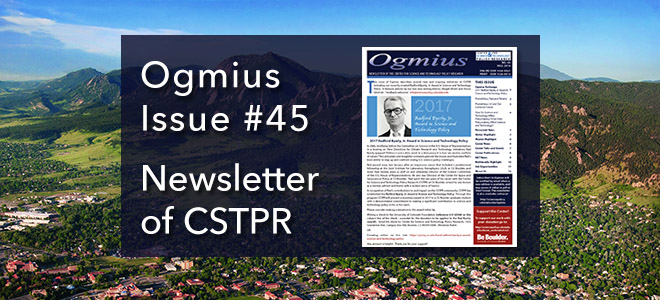


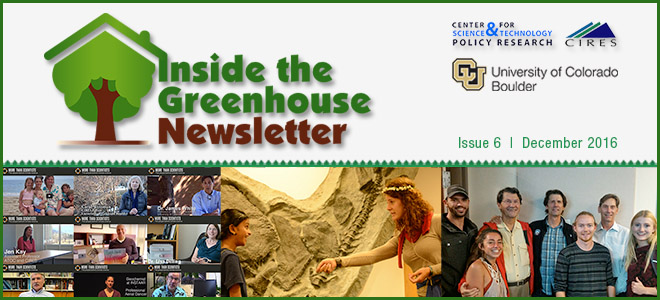
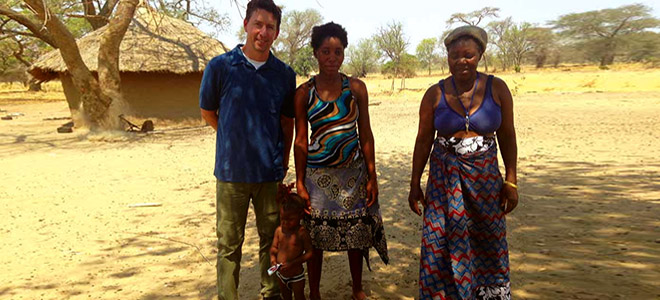
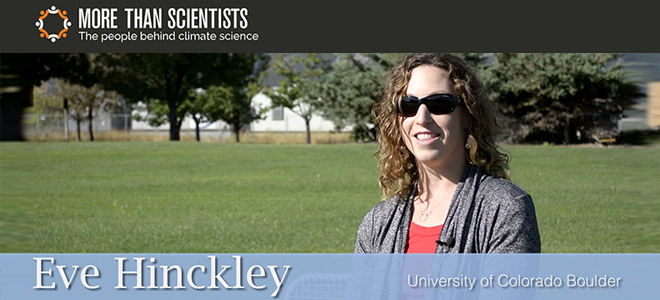
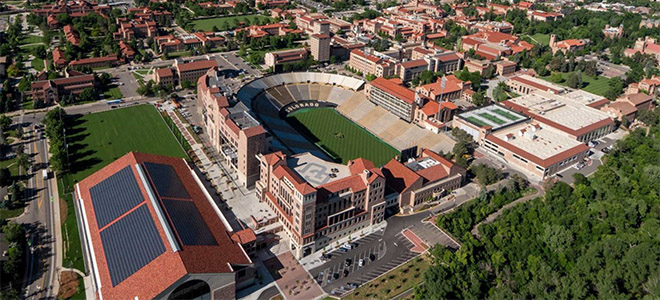
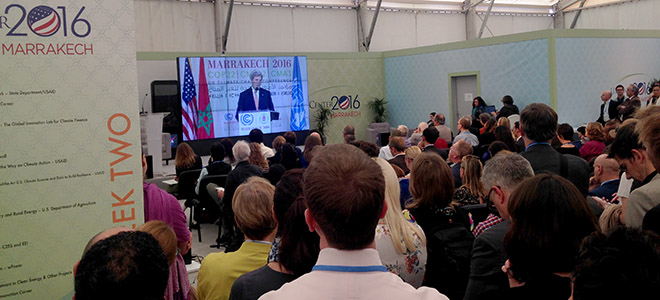
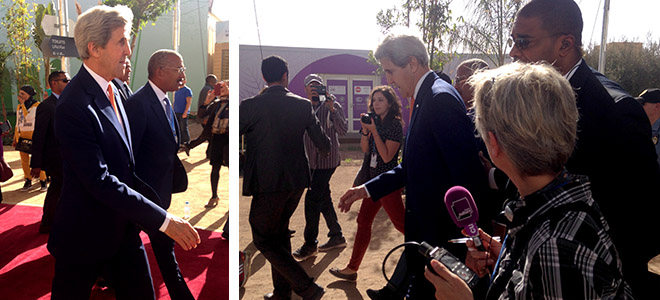 US Secretary of State John Kerry at the Conference of Parties meeting on November 16th
US Secretary of State John Kerry at the Conference of Parties meeting on November 16th Senior climate and energy advisor Brian Deese participates in a side event with Deb Markowitz Secretary of Natural Resources for Vermont, and Diane Holdorf from Kellogg Corporation, moderated by World Resources Institute Global Energy Director Jennifer Layke on November 15th
Senior climate and energy advisor Brian Deese participates in a side event with Deb Markowitz Secretary of Natural Resources for Vermont, and Diane Holdorf from Kellogg Corporation, moderated by World Resources Institute Global Energy Director Jennifer Layke on November 15th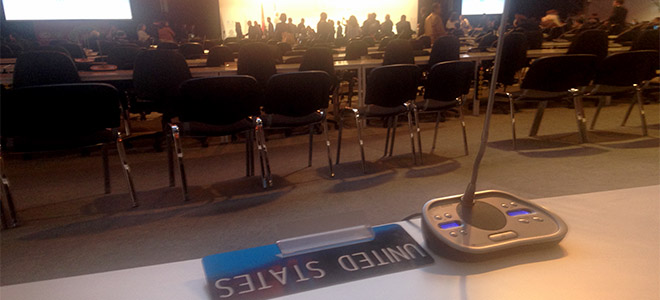 Despite the US being apparently turned upside down by the recent elections, members of the US delegation here in Marrakech have pressed forward with international climate policy cooperation
Despite the US being apparently turned upside down by the recent elections, members of the US delegation here in Marrakech have pressed forward with international climate policy cooperation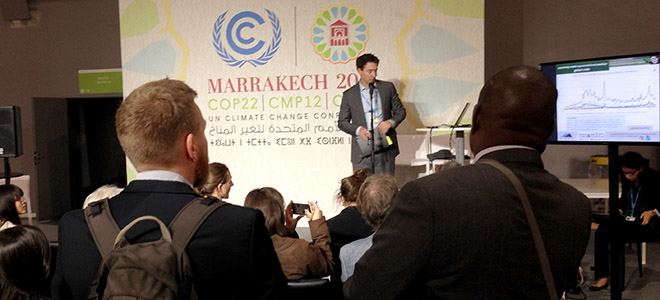 Speaking on Tuesday, Nov 15th about the Media and Climate Change Observatory in the International Environmental Communication Association side event on ‘Communicating Climate Change: Engaging Communities through the Arts, Media, Messages, & Mediation’ in the Climate Change Studio
Speaking on Tuesday, Nov 15th about the Media and Climate Change Observatory in the International Environmental Communication Association side event on ‘Communicating Climate Change: Engaging Communities through the Arts, Media, Messages, & Mediation’ in the Climate Change Studio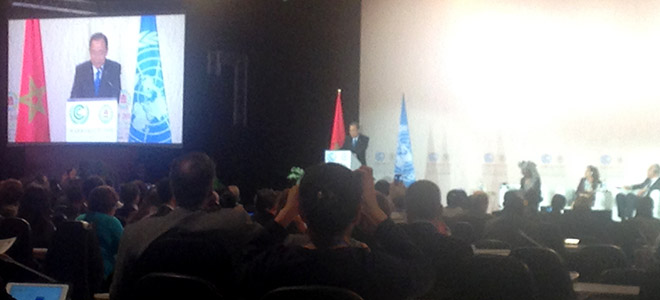 United Nations Secretary General Ban Ki-Moon addresses the COP in a wrap-up plenary session on November 17th
United Nations Secretary General Ban Ki-Moon addresses the COP in a wrap-up plenary session on November 17th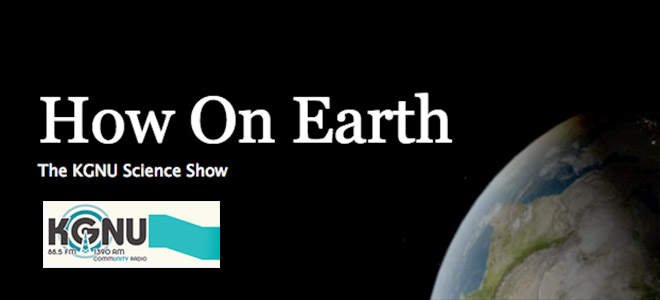

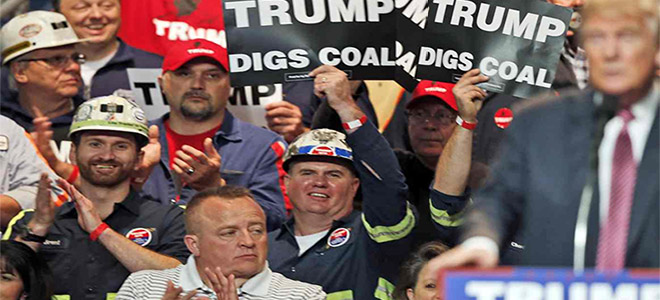
Prices, Peers and Perceptions: Studying a Community’s Adoption of Cleaner Cookware
by Alison Gilchrist, CSTPR Writing Intern
Three billion people, a little over half the world’s population, cook over open fires every day. Those of us with access to microwaves, toasters, rice cookers and waffle irons might not be able to truly grasp what that means for the health of people doing the cooking without such appliances, let alone what it means for the environment to be burning so much solid fuel.
The World Health Organization (WHO) estimates that the exposure to smoke from cooking is responsible for about four million premature deaths a year. Much of the health burden of open fire cooking falls on the women and children, who are in the house while food is being prepared. There are also serious environmental effects, both on the regional scale (poor air quality) and on a much larger scale (the production of black carbon, a serious contributor to climate change). Moreover, the reliance on renewable fuels means greater deforestation in regions where open fires are primarily used for cooking.
Katie Dickinson, a Research Scientist with the CIRES Center for Science and Technology Policy Research (CSTPR), studies how this situation could be improved by a shift to cleaner cooking.
“There are a lot of different options out there,” she says “An open fire isn’t the only way to cook, there are a lot of technological alternatives. But it turns out that finding a technology that works, that is appropriate for a particular culture and their cooking needs, and then getting people to change behaviors towards that technology—there are a lot of steps in there that are very tricky.”
Katie undertook a major project on this topic in 2013in Ghana that recently wrapped up. Now, she has a grant to do a follow-up study in the same area.
In 2013, Katie started working with a team of researchers from CU-Boulder, the National Center for Atmospheric Research (NCAR), and Ghana’s Navrongo Health Research Centre (NHRC) on an intervention project with funding from the NSF’s Dynamics of Coupled Natural Human Systems program and an EPA STAR grant. This study was called Research of Emissions, Air quality, Climate, and Cooking Technologies in Northern Ghana (REACCTING). Two hundred households were randomly selected from the district and were randomly assigned into one of four groups: a group that received two Gyapa cookstoves, a group that received two Philips cookstoves, a group that received one of each, and a control group. The Gyapa stove was specially designed for the study and is appropriate for cooking some of the Ghanaian meal staples; the Philips stove comes with a battery powered fan and is more expensive but potentially cleaner. Both are still wood-burning, but are more efficient than a traditional “three stone stove” (think campfire).
The households were surveyed about how much they liked the stoves and how much they used them. Katie’s group also took objective measurements of how often the stoves were being used, as well as data about what dishes were being cooked with them. They also studied environmental exposure to particulate matter and carbon monoxide, to determine whether the new cook stoves impacted air quality. Finally, they took blood samples from people in the households to study biomarkers that might provide insight about the health impacts of different stoves.
Overall the participants liked the stoves, and used them regularly, although neither of the improved stoves was a perfect fit for the type of cooking and culture in the community—most of the households continued to cook over open fires in parallel. However, households that got the improved stoves did have a lower exposure to some pollutants. This is promising data that suggests improved cooking stoves could have positive health impacts in developing nations.
“As somebody who has always wanted to do interdisciplinary work, I hold this work up as a pinnacle of that kind of study,” says Katie. “I don’t need to be an expert in stove use monitors, because I can rely on an excellent team.”
But as an economist, Katie is even more excited about the follow-up study she will conduct over the next few years. It will build on the past work, and will ask whether people actually buy these cleaner-burning stoves.
“This is a sign of the adoption of technology change,” says Katie. A stove given as a gift is much appreciated, but whether people consider them worth the price is still an open question.
Prices, Peers and Perceptions (P3) was designed to look at how prices and peers—that is, knowing people who have used the stoves before—influence perceptions of the stoves and the likelihood that the stoves are actually purchased.
A new group of participants will be selected based on whether they know people who have used the stoves before, and the experiment will be designed to test whether hearing about the stove influences how much they will spend for it.
The first step was to set an appropriate price, which led to the first field work for this project—an auction. Women were invited to bid for new stoves (updated versions from the first study) in order for Katie’s group to pick a price that would entice some buyers and dissuade others. If the stoves are too cheap, everybody buys one—if the stoves are too expensive, nobody does. If they are priced just right, it’s possible to look at whether other variables influence buying habits.
The auction has informed the price levels that Katie’s group will set for the stoves in the current study, and team members from the NHRC will help monitor who actually buys the stoves and whether the stoves are used. For this phase, Katie’s team is also working with a local NGO that will market the stoves. Her team hopes the research will inform efforts to improve lives and livelihoods in the area.
The goal of the project is to identify which factors are important for changing cooking behaviors and promoting adoption of cleaner stoves. These projects can help us understand what will convince communities to switch to cleaner technology, and may affect the way in which stoves like these are introduced into regions where open fires are still the norm. Hopefully this will decrease exposure to pollutants from solid fuel, and even decrease the environmental burden of wood burning. Stay tuned for updates on Katie’s most recent trip to Ghana and the future of this project!